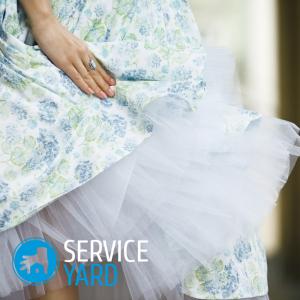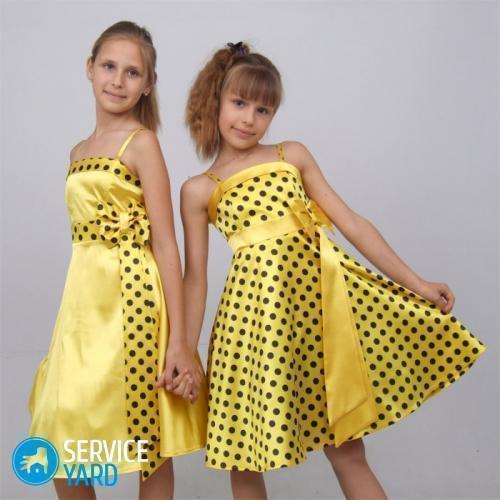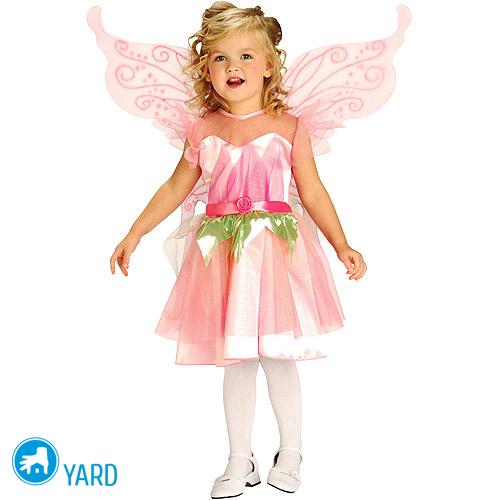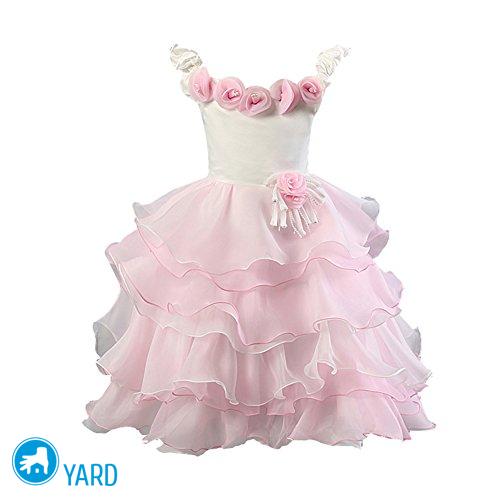How to starch a baby dress 🥝 a petticoat, a starch skirt, video

- Why is the dress starch?
- Where to begin?
- How to decide on technology?
- What things cannot be starch?
- Types of Starch Fixation
- How to starch a dress at home?
- How to starch a dress in a washing machine?
- Alternative to homemade paste
- Antique Starching Methods
- How to starch a wedding dress at home?
- How to starch a baby dress at home?
- How to iron a starched skirt?
- Important points in the process of starching:
- Stock footage
Do you have a solemn moment of the first child's morning party in the kindergarten? Or are you, your eldest daughter, a girlfriend getting married? And the dress, for some reason, after washing dullly hangs on the shoulders and the usual iron does not work out help? Use starch in this case. If you still do not know how to starch a children's dress at home and how to give a more magnificent and festive look to a wedding dress, then this article will help you figure this out and much more.
to contents ↑Why is the dress starch?
For a very long time, the method of starching has been used to give things a stable form, accurate and solemn appearance. Our grandmothers could, with their eyes closed, prepare the right solution for processing this or that dress.
Important! Probably, we all paid attention to the magnificent dresses of ballerinas, how they keep their shape, and which look are snow-white. Not everything depends on the cut and design of the dress. To achieve this effect, you need to be able to properly starch things at home.
A starched dress retains its freshness and magnificent forms longer. This is due to the fact that during the procedure for processing products with a solution, a thin film forms on things, which has the following properties:
- It does not allow the product to wrinkle, as the fabric becomes stiffer.
- The dirt on the dress is not absorbed, which greatly facilitates the process of removing stains during washing.
- The yellowed dress after starch will again take on a white, sparkling appearance.
- The dress keeps a presentable and fresh condition longer.
- Using starch, you can emphasize or highlight such product details as collars, cuffs, ruffles, bows.
Where to begin?
Before starching the skirt at home, you should get rid of all the stains that are present on the product. You can do this as follows:
- Take 3% hydrogen peroxide.
- Apply to a soft, clean cloth.
- Rub the problem areas and leave for a few minutes. The spots will begin to fade right before our eyes.
In this way, not only yellow spots are removed, but also stains from coffee, tea and wine.
to contents ↑Important! In the process of starching, the fabric becomes less breathable. Therefore, light summer things are not advisable to completely starch.
How to decide on technology?
Depending on what you want to get the result from starch: strong or slightly rigid fixation, you must use a certain concentration of starch.
The fabrics from which clothes are sewn differ among themselves in the composition of the threads, color and density. Therefore, you should know which starch solution to use in order to process the fabric of your choice.
to contents ↑Important! For example, under the influence of starch, a knitted dress acquires a number of positive qualities:
- Becomes more presentable.
- Less subjected to stretching.
- The position of the threads becomes more uniform.
- The pattern stands out more clearly on the product.
- Color takes on a more saturated hue.
What things cannot be starch?
There is a second side to the coin: not all things can be starch. Some of them are affected by starch. List of similar products:
- Underwear. Under the influence of starch, the fabric passes less air, therefore, wearing such underwear is not hygienic.
- Things are dark or black. When your clothes are completely dry, white stripes may remain on them.
- Synthetic or semi-synthetic dresses. Such fabrics are difficult to starch.
Types of Starch Fixation
Depending on the desired result and the concentration of the active substance, the following types of starch fixation are distinguished:
Soft Starching Method
With this solution, you can starch summer sundresses from chiffon or cambric, bedding and curtains. Also a great option would be this way to starch a baby dress at home. Thin flowing fabrics will take a hard form with a small amount of starch:
- Take 1 liter of water and dilute in it 0.5-1 teaspoon of starch.
- Stir until a homogeneous mixture.
Medium hard starch
So that the collar and cuffs on the man’s shirt, flounces in the dress and artificial bows, tablecloths and napkins have a stable beautiful shape, prepare the following composition:
- Pour 1 liter of water into enameled dishes and add 1 tablespoon of starch to it.
- Stir until a mixture without lumps.
Hard Starching Method
With this concentrated solution, you can starch only certain sections of clothing: cuffs in a shirt, a petticoat in a ball gown, dance tutus for ballerinas. Products become tough and retain their shape for a long time. The procedure is carried out in compliance with the following rules:
- To give the product a special shine, add 1 teaspoon of borax (boron salt) to the prepared liquid, mix well and let it brew for a couple of hours.
- Dilute 2 tablespoons of starch in 1 liter of water.
- Stir all components until smooth.
to contents ↑Important! Regardless of which type of starching you choose, it is very important that there are no lumps in the resulting raw materials. They will negatively affect the final result.
How to starch a dress at home?
To prepare a starch solution you will need:
- Starch and water.
- Deep enameled or other heat-resistant dishes.
Important! The raw materials may need to be heated on the stove..
- Mixing spoon or spatula.
Important! To prepare the mixture, you can use absolutely any starch: rice, corn, potato or wheat. Experienced housewives prefer to use potato starch. It can be easily purchased at the store. It has a snow-white color, thickens perfectly, which can not be said about corn starch.
To starch a dress at home, adhere to the following algorithm of actions:
- Before lowering things into the resulting liquid, they need to be washed and all stains removed.
Important! Starch has the property of whitening, so all subtle spots after the starching procedure will disappear.
- Pour cold water into enameled dishes and add the required amount of starch to it. Stir the raw materials thoroughly.
Important! The amount of water and starch depends on the method of starch and the type of fabric of your clothes.
- Pour hot water into the mixture in a thin stream. You need to increase the volume of starch fluid to fully cover the product.
Important! The dress to be starched should not float freely in starch fluid.
- Make sure that the product has the consistency of thick sour cream, is transparent and without lumps.
Important! Turbid solution should be boiled for 5 minutes.
- In order for starch to better saturate the fabric, it can be diluted with a small amount of water.
- Wait until the resulting solution has cooled to room temperature.
- Lower the product into the paste.
- Leave on starch for 30 minutes.
- To evenly starch clothes, turn them over several times in containers.
- Remove the dress, remove excess fluid from the product, straighten folds and creases.
- Spread to dry at room temperature in a horizontal position or hang on a coat hanger.
- Drying should be done away from the battery or heat generator.
Important! Having dried on the battery, the dress will be difficult to smooth and give it the desired shape.
- To iron the fabric of the product well and give it the desired shape, iron it is necessary to wet it.
- If you like the effect of starching, repeat it with each wash.
How to starch a dress in a washing machine?
Now there is a washing machine in almost every home. It can not only wash and rinse, but also starch fabric products. To do this, you need to do the following:
- Dilute the starch with water in proportions corresponding to the desired fixation result and type of tissue.
- Pour the starch solution into the air conditioning compartment and set the desired washing mode in the automatic machine.
Important! If you prefer washing with a softener, conditioner, then during starching, you should refuse it.
- To avoid harming the washing machine, start it idle after starching.
- Wipe the drum and door with a dry, clean cloth.
Alternative to homemade paste
Today, during the period of technological progress, it is not necessary to prepare a starch paste at home. In trade pavilions or large supermarkets you can purchase starches in the form of a spray, liquid or powder.
Spray
This form of fabric starching agent is very convenient to use. This is especially true when you need to starch only certain sections of clothing: collars, cuffs or frills on the dress. All that is needed is to spray the product onto the clothes while ironing.
Powder or Liquid Starch
Such things as tablecloths, curtains, tulle, a petticoat of a dance dress and other overall things, it is very difficult to starch by hand. Therefore, often use a tool that is specifically designed for a washing machine.
to contents ↑Important! Before using any store tool, read and follow the instructions for use.
Antique Starching Methods
Previously, our grandmothers and great-grandmothers found a way out. For these purposes, they often used sugar, gelatin, and a little later, in some cases, PVA glue.
Sugar:
- A stiff form of clothing is given thanks to the syrup, which is boiled in the ratio: 100 ml of water per 200 g of sugar.
Important! It is very important not to digest the syrup. Otherwise, your item will become undesirable yellowness.
- Pre-prepare a solution with starch and pour the cooled syrup into it.
- Stir the resulting mixture.
Important! If lumps remain, you can strain the paste through cheesecloth.
- Lower the product and let it soak for a while.
- Wring out excess fluid.
- Place to dry horizontally.
Important! Under the influence of water, clothes will lose their acquired shape and stiffness. Therefore, make sure that the product does not come into contact with water after starching.
PVA glue
This method is perfect for knitwear or embroidery. To give things rigidity and the correct position of the threads, so that the pattern on the product looks more expressive, prepare the following tool:
- In a ratio of 1: 2, dilute the PVA glue with water.
- Put the product in the prepared paste.
Important! If you need to process individual parts, apply the tool with a brush.
- Leave to dry straightened.
Gelatin
Get gelatin from the grocery store and prepare the following solution:
- One tablespoon should be diluted in warm water until completely dissolved.
- Pour 200-250 ml of water into the gelatin liquid obtained.
- Put the dress in the resulting composition.
- Once it is saturated with gelatin, wring it out and put it to dry.
How to starch a wedding dress at home?
A wedding dress may consist of several layers of skirts. If you starch all layers of the petticoat, you get a gorgeous fluffy dress.
Important! To achieve a slightly fluffy skirt, starch only a few layers of the petticoat. Thus, your dress will have a hard bottom that will hold all the other parts of the skirt, and the dress will acquire a gentle airy look.
You can not spoil such a beautiful and expensive outfit, so proceed as follows:
- Make a paste for a hard way of starching.
- Work it on the lowest skirt.
Important! The topmost skirt of a dress is never processed with starch.
- Do not wait until it dries. When wet, use a warm iron to iron it.
Important! To prevent the fabric from sticking to the iron, you need to iron it through gauze.
- Treat all subsequent layers of the petticoat with starch of any hardness.
How to starch a baby dress at home?
An elegant children's dress after washing can have a completely non-holiday look. Ruffles and bows after “water procedures” become drooping and badly wrinkled. To give a solemn and neat look to this product, perform the following steps that will help to quickly and correctly starch a children's dress at home:
- Make a paste for hard starch.
- Starch individual details: collars, ruffles, bows, petticoats.
- Iron a damp cloth with a warm iron.
How to iron a starched skirt?
There are several rules, compliance with which is necessary in order for the thing to have an excellent appearance:
- Ironing the skirt is slightly damp. With this approach, all folds and creases can be easily smoothed out without damaging the shape of the product.
- You cannot use steam in the ironing process - the skirt may lose its acquired stiffness.
- If the product is still dry, sprinkle it with water or cover it with a slightly damp cloth and iron it.
- Do not use a hot iron. As a result, yellow marks may appear on clothing.
- To prevent the skirt from sticking to the iron, turpentine can be added to the starch.
Important points in the process of starching:
- Salt added to the paste will give the dress a unique sheen.
- Additional shine can be obtained by adding a few drops of stearin to the solution.
- Do not leave starches to dry in the cold. With such drying, the product will not become stiff.
- Clothes on which there are elements of embroidery with mouline thread cannot be starch, as the threads lose their color and stick together.
- Knitted items cannot be dried on a hanger, they should be laid out in a horizontal position and secured in the necessary form with sewing pins.
Stock footage
With the help of simple starching actions, your daughter will look like a little princess in her magnificent dress, and a starched wedding dress will give the bride a gentle, airy look. Using the simple tips from this article, you will learn how to give your things a special gloss and beauty.
- How to choose a vacuum cleaner taking into account the characteristics of the house and coatings?
- What to look for when choosing a water delivery
- How to quickly create comfort at home - tips for housewives
- How to choose the perfect TV - useful tips
- What to look for when choosing blinds
- What should be running shoes?
- What useful things can you buy in a hardware store
- Iphone 11 pro max review
- Than iPhone is better than Android smartphones







